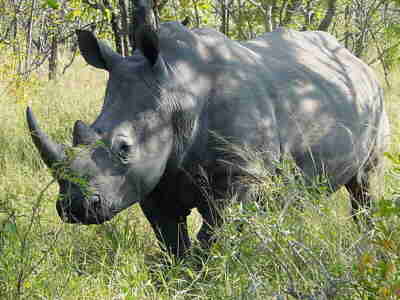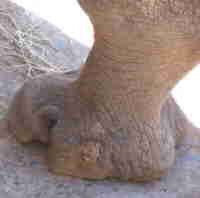 SKC Films Library SKC Films Library |
|
|
| SKC Films Library >> Science >> Zoology >> Mammals >> Order Perissodactyla |
| White Rhinoceros Ceratotherium simum [suh rah tuh ther' E um sim' um] Description One of the largest land animals on Earth, the white rhinoceros is 11 to 14 feet long, not counting its 20-28-inch tail, stands 5-6 feet at the shoulder, and weighs 3,000-8,000 pounds; males are larger than females. Despite its name, it is actually light gray to dark yellow in color.
Like its close cousin the black rhinoceros, the white rhinoceros has two horns made of keratin fibers, with the front horn always being longer than the rear horn. It also has three very distinct toes on each of its four massive feet. Both species of rhinoceros have poor eyesight, fairly good hearing, and excellent sense of smell. The white rhinoceros is distinguished from its cousin by its wide, square upper lip; the black rhinoceros has a more curved upper lip.
Distribution and Habitat There are two distinct populations of white rhinoceros, one in northeastern Africa confined almost entirely to Kenya and another spread through much of southern Africa. It lives in open woodlands with nearby open grassland, thick brush, and water and prefers flat lands, but is occasionally found in swamp regions. Diet The white rhinoceros feeds almost exclusively on grasses, grasping large clumps with its mouth and gently swinging its massive head back and forth to help its teeth cut through the blades. Although it will drink at least once a day when water is available, it can go up to a week or so without drinking when water is scarce. Reproduction Breeding takes place throughout the year, but is most common in the summer and fall. Potential breeding pairs will court each other for about three weeks, with the female coming into the bull's territory to mate when she is ready; bulls rarely chase after unreceptive females, and there is virtually no competition between males for mates. The cow gives birth to one calf after a gestation period of about 16 months. The calf will be closely protected by its mother for about two years, at which time she will chase it away; only then will she mate again. Sexual maturity is reached at about six years of age in females, 10-12 years in males. A white rhinoceros can live up to 50 years in the wild. Other Information White rhinoceroses are generally solitary, but they will congregate in small herds (crashes) composed of either immatures or females without young; they never congegate in mixed herds, and adult males are always solitary except when breeding. The white rhinoceros is not as endangered as the black rhinoceros, but is still threatened by habitat encroachment and poaching. Scientific Classification phylum Chordata
SEE ALSO |
SKC Films Library >> Science >> Zoology >> Mammals >> Order Perissodactyla This page was last updated on February 17, 2017. |

